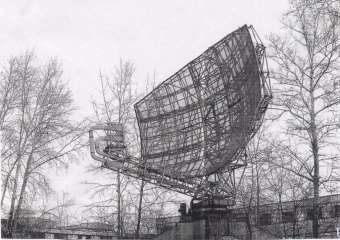Utes-A and Utes-T
Description of the radar set, tactical-technical characteristics

Figure 1: Utes-T

| Specifications | ||
|---|---|---|
| Utes-A | Utes-T | |
| frequency: | 1 240 … 1 350 MHz
(L-Band) | |
| pulse repetition time (PRT): | ||
| pulse repetition frequency (PRF): | ||
| pulsewidth (τ): | 80 µs; 1.6 µs | 120 µs; 1.6 µs |
| receive time: | ||
| dead time: | ||
| peak power: | 35 kW | |
| average power: | 1.5 kW | |
| instrumented range: | 160 km | 360 km |
| range resolution: | 250 m | |
| accuracy: | 150 m; 0.15° | |
| beamwidth: | 1.5° | |
| hits per scan: | ||
| antenna rotation: | 12 min-1 | 6 min-1 |
| MTBCF: | 10 000 h | |
| MTTR: | 0.5 h | |
Utes-A and Utes-T
Utes-A (Cyrillic: Утёс-А , engl.: “Cliff”) and Utes-T (Cyrillic: Утёс-Т ) are operating in L-Band fully coherent air traffic control radars. Utes-A (aerodrome) is predetermined to as terminal area radar with a lower maximum range but higher data renewing rate. It has two electronic racks with 16 booster modules each. Utes-T (trace) is predetermined to as en-route radar with higher peak power and larger maximum range. It has four electronic racks with 16 booster modules each.
The antenna is a double curved parabolic reflector with the dimensions of 10.5 × 13.6 meter, providing a cosecant squared pattern. The reflector is fed by two feed horns (high- and low-beam). The radars are frequency-diversity radar. They work in the frequency band on two frequencies at a distance of 54 MHz. Both frequencies are transmitted simultaneously, but only on the low-beam channel. The radar has four independent receiving channels (high- and low-beam for each frequency). The optional MSSR antenna is located on the same turntable as the primary radar antenna and is mounted on the rear of the primary reflector.
Source:
- Manufacturers home page
